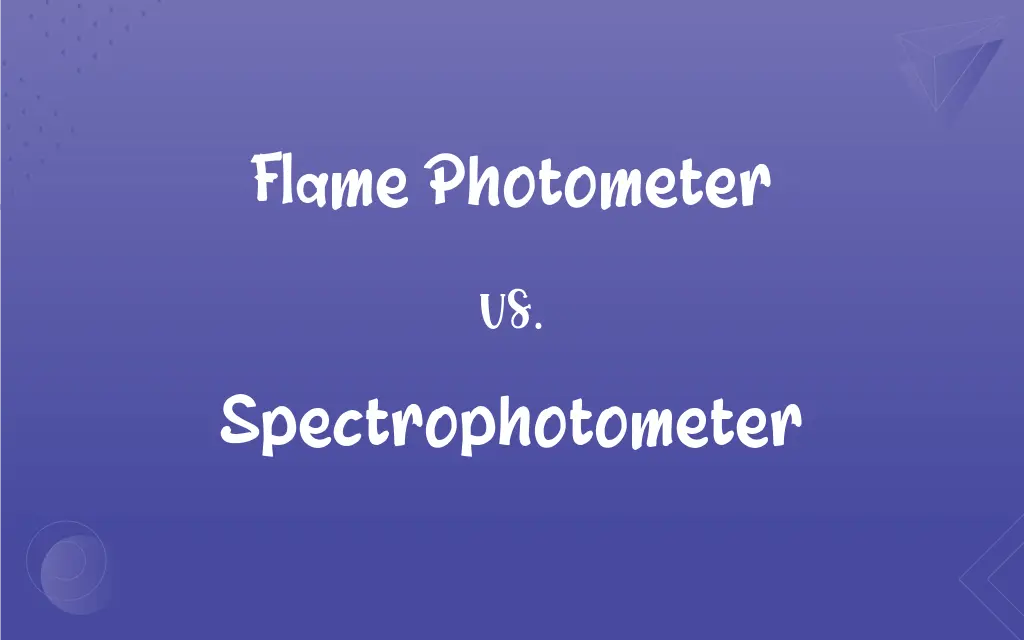Flame Photometer vs. Spectrophotometer: What's the Difference?
By Janet White & Harlon Moss || Published on April 1, 2024
A flame photometer measures the concentration of certain metal ions using flame emission, while a spectrophotometer measures light absorption across a spectrum to analyze various substances.

Key Differences
Flame Photometer operates on the principle of flame emission spectroscopy, where a sample solution is aspirated into a flame, causing certain metal ions (e.g., sodium, potassium, calcium, and lithium) to emit light at characteristic wavelengths. The intensity of this light emission is directly proportional to the concentration of the metal ion in the sample. Spectrophotometer, on the other hand, is a versatile instrument that measures how much light a chemical substance absorbs at various wavelengths. By passing light through a sample and measuring the intensity of light before and after, it can determine the absorbance or transmittance, which is then used to calculate the concentration of the substance.
The choice between a flame photometer and a spectrophotometer depends largely on the specific needs of the analysis. For precise and rapid measurement of certain metal ions, a flame photometer is preferred. In contrast, for a broader range of substances and when the interest lies in a wide spectrum of wavelengths, a spectrophotometer offers more versatility and applicability.
Flame photometry is relatively simple and cost-effective for its specific applications, spectrophotometry provides greater flexibility, allowing for both qualitative and quantitative analyses of various substances. The latter can measure at specific wavelengths that correspond to the absorbance peaks of different compounds, enabling detailed analysis of complex mixtures.
Both instruments are essential in scientific research and industrial applications for measuring concentrations of substances, their methodologies, applications, and the range of substances they can analyze differ significantly.
Comparison Chart
Principle
Measures light emission from a flame
Measures light absorbance or transmittance
ADVERTISEMENT
Application
Specific metal ions (e.g., Na, K, Ca, Li)
Broad range of substances
Methodology
Flame emission spectroscopy
Absorbance/transmittance spectroscopy
Usage
Clinical, pharmaceutical, environmental analysis
Biochemistry, molecular biology, chemistry
Flexibility
Limited to certain metal ions
Wide spectrum of wavelengths for various substances
Output
Intensity of light emission correlates to ion concentration
Absorbance or transmittance indicates substance concentration
ADVERTISEMENT
Preferred for
Rapid and precise measurement of metal ions
Versatile analysis of nucleic acids, proteins, etc.
Flame Photometer and Spectrophotometer Definitions
Flame Photometer
Offers rapid results for targeted ion detection.
Agricultural soil testing for potassium concentration with a flame photometer.
Spectrophotometer
Versatile in its application across numerous scientific fields.
Analyzing plant pigments by measuring their absorbance spectra.
Flame Photometer
Cost-effective for its specific applications.
Cost savings in pharmaceutical quality control by using a flame photometer for sodium analysis.
Spectrophotometer
An instrument that quantifies how much light a sample absorbs at various wavelengths.
Determining the concentration of a protein solution by measuring its absorbance at 280 nm with a spectrophotometer.
Flame Photometer
Primarily used for analyzing electrolytes in clinical laboratories.
Monitoring sodium levels in hydration studies using a flame photometer.
Spectrophotometer
Enables detailed analysis of complex mixtures.
Monitoring chemical reactions over time by measuring changes in absorbance.
Flame Photometer
A device that determines the concentration of specific metal ions by measuring the light they emit when introduced to a flame.
A flame photometer can quickly assess the potassium levels in blood samples.
Spectrophotometer
Can be used for both qualitative and quantitative analysis.
Identifying unknown compounds by their absorbance peaks.
Flame Photometer
Relatively simple operation and maintenance.
Routine calibration with standard solutions ensures accurate flame photometer readings.
Spectrophotometer
Essential for molecular biology studies, such as nucleic acid quantification.
Assessing RNA purity and concentration by spectrophotometry.
Spectrophotometer
An instrument used to determine the relative intensity of various wavelengths in a spectrum of light.
Spectrophotometer
(physics) An instrument used to measure the intensity of electromagnetic radiation at different wavelengths.
Spectrophotometer
An instrument for measuring or comparing the intensities of the colors of the spectrum.
Spectrophotometer
An analytical instrument for measuring the degree of absorption of light at different wavelengths by a chemical substance. A specific pattern of absorption intensities at a series of wavelengths is a characteristic of each different chemical substance.
Spectrophotometer
A photometer for comparing two light radiations wavelength by wavelength
FAQs
Can a flame photometer measure organic compounds?
No, a flame photometer is specifically designed for measuring the concentration of certain metal ions and is not suitable for organic compounds.
How does a spectrophotometer work?
A spectrophotometer works by shining light through a sample and measuring the absorbance or transmittance of light at different wavelengths to determine the concentration of substances in the sample.
Is a spectrophotometer suitable for water quality analysis?
Yes, a spectrophotometer is highly suitable for water quality analysis. It can measure the concentration of pollutants, organic compounds, and inorganic ions in water, making it invaluable for environmental monitoring and research.
How does the accuracy of a flame photometer compare to that of a spectrophotometer?
The accuracy of a flame photometer for its specific applications, such as measuring certain metal ions, is very high. However, a spectrophotometer offers broader accuracy across a wide range of substances due to its ability to measure absorbance at specific wavelengths tailored to the absorbance peaks of different compounds.
What substances can be analyzed with a spectrophotometer?
A spectrophotometer can analyze a wide range of substances, including nucleic acids, proteins, organic compounds, and inorganic ions, by measuring their absorbance or transmittance at specific wavelengths.
What is a flame photometer used for?
A flame photometer is used for measuring the concentration of specific metal ions, such as sodium, potassium, calcium, and lithium, in various samples.
Can a spectrophotometer measure the same ions as a flame photometer?
A spectrophotometer can measure ions if they form colored complexes with specific reagents that absorb light at particular wavelengths. However, for direct measurement of metal ions based on emission, a flame photometer is more straightforward and specialized.
How do sample preparations for a flame photometer and a spectrophotometer differ?
Sample preparation for a flame photometer often involves dilution to fit within the optimal detection range and may require removal of interfering substances. For a spectrophotometer, preparation might involve adjusting the pH, adding reagents to form colored complexes, or filtering the sample to remove particulates.
Why choose a flame photometer over a spectrophotometer for metal ion analysis?
A flame photometer is preferred for specific metal ion analysis due to its simplicity, rapid results, and cost-effectiveness for the targeted measurement of ions like sodium, potassium, calcium, and lithium. It is specifically optimized for these ions, providing quick and accurate measurements essential in clinical, environmental, and agricultural settings.
What safety precautions are necessary when operating a flame photometer?
Safety precautions for operating a flame photometer include ensuring proper ventilation to avoid inhalation of potentially toxic fumes, handling chemicals safely, and using appropriate protective gear to prevent burns from the flame.
How do environmental factors affect measurements taken by a flame photometer and a spectrophotometer?
Environmental factors such as temperature, humidity, and the presence of other substances can affect measurements. Flame photometers might be influenced by the flame's stability and sample preparation, while spectrophotometers can be affected by the clarity of the sample and the condition of the cuvette.
Are there any advancements in flame photometry technology?
Recent advancements in flame photometry include improved sensitivity, better control over the flame conditions, and enhanced data processing capabilities, allowing for more accurate and rapid analysis of metal ions.
What role do these instruments play in pharmaceutical analysis?
In pharmaceutical analysis, flame photometers are used to measure electrolyte levels in medications and bodily fluids, whereas spectrophotometers are essential for quantifying drug components, assessing purity, and studying drug interactions.
Can both instruments be used in the food industry?
Yes, both instruments find applications in the food industry. Flame photometers can analyze mineral content, while spectrophotometers are used for colorimetric assays, nutrient quantification, and determining the concentration of additives.
How does the complexity of operating these instruments compare?
Flame photometers are generally simpler to operate, focusing on the analysis of specific ions, while spectrophotometers require more knowledge about selecting appropriate wavelengths and preparing samples for a broad range of analyses.
What future developments are expected in the field of photometry and spectrophotometry?
Future developments may include further miniaturization of devices, increased automation, improved sensitivity and specificity, broader range of detectable substances, and enhanced user-friendly software for data analysis, expanding their applications in scientific research and industry.
What are the limitations of using a flame photometer?
The main limitations of a flame photometer include its restriction to analyzing only certain metal ions and the potential interference from other ions or substances in the sample that might affect the accuracy of its measurements.
Can these instruments be integrated into automated laboratory systems?
Both flame photometers and spectrophotometers can be integrated into automated laboratory systems, allowing for high-throughput analysis, data management, and reduced manual intervention, enhancing efficiency and accuracy in various research and industrial settings.
What are the maintenance requirements for a flame photometer versus a spectrophotometer?
Maintenance for a flame photometer includes regular cleaning of the burner and nebulizer to prevent clogging and ensure accuracy. Spectrophotometers require calibration with standard solutions, cleaning of optical components, and ensuring that the light path is free from obstructions.
How does the cost of ownership compare between the two instruments?
The initial cost of a flame photometer might be lower than that of a spectrophotometer, but the specific needs for reagents and maintenance can vary. Spectrophotometers, given their versatility and range of applications, might represent a higher upfront investment but offer broader utility.
About Author
Written by
Janet WhiteJanet White has been an esteemed writer and blogger for Difference Wiki. Holding a Master's degree in Science and Medical Journalism from the prestigious Boston University, she has consistently demonstrated her expertise and passion for her field. When she's not immersed in her work, Janet relishes her time exercising, delving into a good book, and cherishing moments with friends and family.
Co-written by
Harlon MossHarlon is a seasoned quality moderator and accomplished content writer for Difference Wiki. An alumnus of the prestigious University of California, he earned his degree in Computer Science. Leveraging his academic background, Harlon brings a meticulous and informed perspective to his work, ensuring content accuracy and excellence.































































